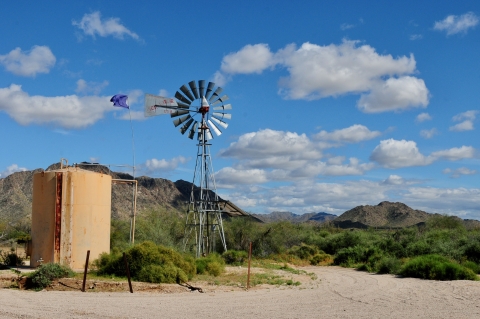What We Do
The National Wildlife Refuge System is a series of lands and waters owned and managed by the U.S. Fish and Wildlife Service. Wildlife conservation is at the heart of the refuge system. It drives everything we do from the purpose a refuge is established, to the recreational activities offered there, to the resource management tools we use. Selecting the right tools helps us ensure the survival of local plants and animals and helps fulfill the purpose of the refuge. Here are just a few of the things we do at the refuge:
Sonoran pronghorn conservation
The endangered Sonoran pronghorn is a species of particular importance at Cabeza Prieta National Wildlife Refuge. For thousands of years, Sonoran pronghorn migrated seasonally within the vast Sonoran Desert – from Southwest Arizona and California down into the northern portion of Sonora, Mexico. During times of drought, the well-adapted pronghorn would travel long distances to find food and water sources elsewhere.
Several factors, including human settlement, livestock grazing, disease, and drought contributed to the decline of Sonoran pronghorn. In 2002, after a year of severe drought, the population of Sonoran pronghorn in the United States plummeted to just 21 individuals.
In an effort to prevent the extinction of the species, the U.S. Fish and Wildlife Service and its partners began a captive breeding program in 2003. Working with other agencies and Mexico, seven pronghorn were captured to start the program. Over the years, pronghorn born through the captive breeding program have been successfully released into the wild, and help to supplement existing wild pronghorn populations. Today, there are estimated to be over 450 Sonoran pronghorn in the United States–over a 2000 percent increase–making it one of the most successful restoration projects in recent U.S. history.
Invasive species removal
There are many species on the refuge that were unnaturally introduced by people sometimes intentionally, other times unintentionally. Unfortunately, some of these species have taken over the landscape because they have no natural predators to keep their population in check. This puts the fragile ecosystem at risk. Today, one of the most common invasive species invasive species
An invasive species is any plant or animal that has spread or been introduced into a new area where they are, or could, cause harm to the environment, economy, or human, animal, or plant health. Their unwelcome presence can destroy ecosystems and cost millions of dollars.
Learn more about invasive species on the refuge is buffelgrass. It was introduced to the United States in the 1930s for erosion control and livestock forage. Large amounts of buffelgrass can be hazardous because they serve as good tinder for fire, which could destroy a fragile desert ecosystem not yet adapted to withstanding fires.
Maintaining water catchment systems
The refuge also works to preserve other wildlife by maintaining man-made and reinforced natural tinajas (water pockets). These waters are available to all wildlife on the refuge and are especially important in the heat of the summer and during drought conditions. The Sonoran Desert truly teaches that water is life and this aids in the conservation of wildlife in this habitat.
Forage enhancement plots
Forage enhancement plots are areas of the desert that are irrigated so herbivores such as Sonoran pronghorn have access to high-quality forage during periods of drought.


